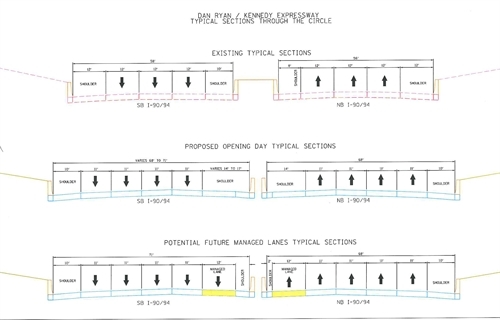
Flickr user Mike Miley (cc)
The Circle Interchange in winter
The Chicago region is one of the nation’s largest and its roads are some of the nation’s most congested. The Ill. Dept. of Transportation (IDOT) argues that the reconstruction and expansion of the Circle Interchange is an essential component of any plan to reduce congestion and improve mobility in the region.
In March, the Chicago Metropolitan Agency for Planning (CMAP) voted to amend the region’s GO TO 2040 plan by adding the Circle Interchange to the list of approved major capital projects. This was a required step for the Interchange project to receive federal funding and clears the way for the project to begin construction next year.
The Metropolitan Planning Council (MPC) voiced several concerns about the process that led to the project’s approval. MPC objected to the Circle Interchange project being proposed for inclusion in the region's transportation plan because it was not vetted through the established prioritization process in GO TO 2040. MPC argued the process for considering those amendments should mimic that which all projects followed during the five-year planning effort that resulted in the GO TO 2040 plan.
Now that the Circle Interchange has been added to the list of regional priorities, MPC is considering what value the project will bring to the metropolitan area. Certainly, the reconstruction of an aging highway facility is an important element of MPC’s and CMAP’s goal to prioritize maintaining existing facilities in a state of good repair. The large majority of funding for the project is being devoted to renovating the current road.
The Circle Interchange also has the potential benefit of providing room for the future implementation of tolled lanes in the Chicago central area. As the following image shows, the Interchange is located at the confluence of four major regional highways. In a recent study, CMAP recommended the implementation of congestion pricing on I-55 (the Stevenson) and I-290 (the Eisenhower), each of which could be expanded with new tolled lanes. In addition, there are currently free express lanes on I-90/I-94 South (the Dan Ryan) and reversible peak-hour lanes on I-90/I-94 North (the Kennedy). These lanes could potentially be tolled as part of a congestion pricing regime.

Chicago-area facilities that may see managed lanes.
IDOT
The Circle Interchange will add an additional lane in both directions to both I-290 and I-90/I-94 through the intersection (see the following image). IDOT estimates that these additional lanes will cut down on congestion through the area. More promising in terms of offering congestion relief is the fact that the project has the potential to allow for the implementation of congestion pricing by converting the new shoulders built into the expanded Interchange into tolled lanes in both directions. This is one potentially important benefit of the construction of this project.

Proposed lane sections for Circle Interchange renovation.
IDOT
The implementation of tolled lanes through the Circle Interchange would provide drivers an alternative to congestion, but there are a couple of obstacles standing in the way of congestion pricing on the Circle Interchange. For one, the addition of tolled lanes to the shoulders would require additional expenditure and potentially negative construction impacts. There is no funding currently allocated to pay for this portion of the project.
Just as important, federal law currently prohibits tolling on existing Interstate highway lanes. As a result, IDOT and CMAP are prohibited from installing tolled lanes on I-90/I-94, for example.
MPC is working to change federal transportation law to allow existing transportation capacity to be tolled. MAP-21, the most recent transportation bill, however, eliminated the Express Lanes Demonstration Project, which permitted tolling on select highways to manage traffic and reduce pollution. Until federal laws change, many of the potential future benefits of the Circle Interchange will be impossible to realize. MPC supports Illinois Senator Kirk’s Lincoln Legacy Act to advance congestion pricing and increase transportation investments through public-private partnerships.